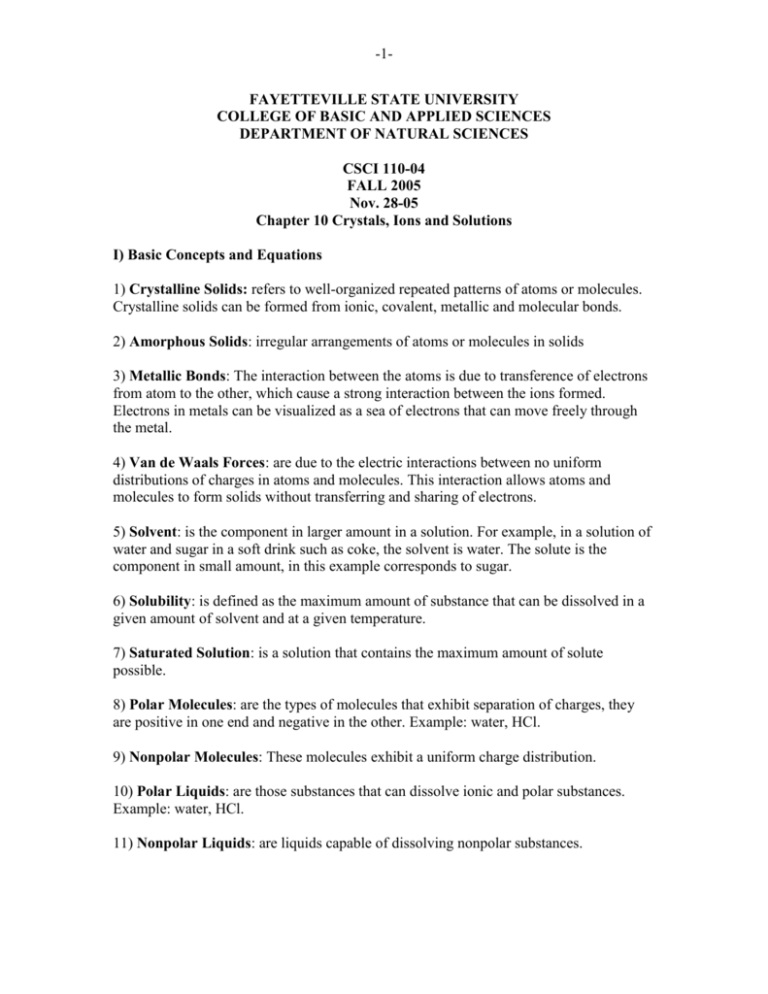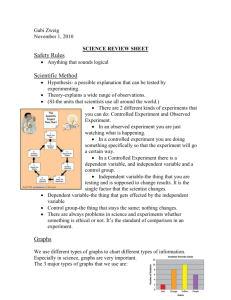Chapter 10 - Fayetteville State University
advertisement

-1FAYETTEVILLE STATE UNIVERSITY COLLEGE OF BASIC AND APPLIED SCIENCES DEPARTMENT OF NATURAL SCIENCES CSCI 110-04 FALL 2005 Nov. 28-05 Chapter 10 Crystals, Ions and Solutions I) Basic Concepts and Equations 1) Crystalline Solids: refers to well-organized repeated patterns of atoms or molecules. Crystalline solids can be formed from ionic, covalent, metallic and molecular bonds. 2) Amorphous Solids: irregular arrangements of atoms or molecules in solids 3) Metallic Bonds: The interaction between the atoms is due to transference of electrons from atom to the other, which cause a strong interaction between the ions formed. Electrons in metals can be visualized as a sea of electrons that can move freely through the metal. 4) Van de Waals Forces: are due to the electric interactions between no uniform distributions of charges in atoms and molecules. This interaction allows atoms and molecules to form solids without transferring and sharing of electrons. 5) Solvent: is the component in larger amount in a solution. For example, in a solution of water and sugar in a soft drink such as coke, the solvent is water. The solute is the component in small amount, in this example corresponds to sugar. 6) Solubility: is defined as the maximum amount of substance that can be dissolved in a given amount of solvent and at a given temperature. 7) Saturated Solution: is a solution that contains the maximum amount of solute possible. 8) Polar Molecules: are the types of molecules that exhibit separation of charges, they are positive in one end and negative in the other. Example: water, HCl. 9) Nonpolar Molecules: These molecules exhibit a uniform charge distribution. 10) Polar Liquids: are those substances that can dissolve ionic and polar substances. Example: water, HCl. 11) Nonpolar Liquids: are liquids capable of dissolving nonpolar substances. -212) Dissociation of Compounds: refers the ability of some compounds to separate in its components ions in a given solvent. Example: NaCl dissociate in Na+ and Cl- in water. 13) Electrolytes: are those compounds that dissociate in their components ions in water. 14) Acids: are substances that when they dissociate in water give H+ ions. Example: HCl, H2SO4. 15) Basis: are substances that when they dissociate in water give OH- ions. Example: NaOH. 16) pH: measures the degree of acidity or basicity of a given solution. Acid solutions exhibit pH lower than 7.00, basic solutions pH larger than 7.00 and neutral solution a pH of 7.00 (no acid no basic solution) 17) Neutralization: refers to reaction between an acid and a base or between H+ and OHions to give water. 18) Salts: ionic compounds are formed from metal and nonmetal atoms. They are formed from the neutralization reaction between an acid and a base. Example: HCl(aq) + NaOH(aq) H2O + NaCl(s), where the salt is the solid NaCl compound. II Tests 1. In a chemical reaction the element sodium (Na) will A. lose an electron. B. lose two electrons. C. gain an electron. D. neither gain nor lose electrons. 2. Ionic bonds are formed when A. electrons are transferred from the excited to the ground state. B. electrons are transferred from the ground state to the excited state. C. electrons are transferred between atoms. D. atoms share electrons. 3. Covalent bonds are formed when A. electrons are transferred from the excited to the ground state. B. electrons are transferred from the ground state to the excited state. C. electrons are transferred between atoms. D. atoms share electrons. 4. The number of atoms in a molecule of ammonium sulfate, (NH4)2SO4, is A. 4. B. 10. C. 14. D. 15. -35. When the atoms of a metal combine chemically with the atoms of a nonmetal, the nonmetal ions tend to A. become positive ions. B. remain neutral. C. become negative ions. D. share electrons. 6. A crystal grain of potassium chloride is made up of A. K- and Cl+ ions. B. K+ and Cl- ions. C. molecules of KCl. D. atoms of K and Cl. 7. The sulfate ion is (SO4)2- so the formula for calcium sulfate would be A. CaSO4. B. Ca2SO4. C. Ca2(SO4)2. D. Ca2(SO4)3. 8. Ionic compounds are usually composed of A. two metals. B. two nonmetals. C. a metal and a nonmetal. D. a metal and a semiconductor. 9. If the correct formula for sodium bicarbonate is NaHCO3, then the formula for calcium bicarbonate would be A. CaHCO3. B. Ca(HCO3)2. C. Ca2HCO3. D. CaHCO2. 10. Which of the following is an example of a molecular crystal type? A. diamond B. common salt (sodium chloride) C. copper wire D. ice 11. In which of the following crystal types would you expect to find high thermal conductivity? A. covalent B. ionic C. metallic D. molecular -412. A solute in a solution A. can never exceed its solubility. B. must always be nonpolar. C. can sometimes exceed its solubility, forming a supersaturated solution. D. must be a solid when it is not in the solution.






